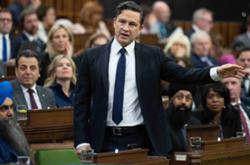A federal policy choice has put 40,000 of the most vulnerable Canadian households at risk of homelessness in the last year.
Letting decades-old agreements expire, the federal government has directed the Canada Mortgage and Housing Corp. (CMHC) to stop providing the subsidies that kept their rents affordable.
Without that national support, social housing providers have had to raise rents -- defeating their purpose; sell units -- leaving fewer for the needy; develop social enterprises to subsidize their budget -- a risky gamble; or shut down. It's the last desperate act that could put tenants out on the street with few affordable alternatives.
Every year, more agreements that CMHC signed in a long-ago era of optimism expire, and more thousands of households become vulnerable. In all, more than half a million affordable housing units sheltering low-income and marginalized Canadians will be cut loose by 2040.
CMHC's spending on social housing, frozen for two decades, will go from close to $2 billion a year to zero. That will leave its top priority in recent decades -- insuring banks against mortgage losses -- as its only line of business.
Changes, of course, are nothing new for Canada's national housing agency. Seventy years old next January, the CMHC has served governments of every stripe. Its powers under the National Housing Act allow it to do as much, or as little, as the government of the day wishes.
To Michael Shapcott, who represents North America on the Habitat International Coalition, watching CMHC's retreat from social housing has been "like glaciers melting. You don't see the changes from day to day, but it's remarkable to see it over two, three or four decades."
Shapcott calls it a "one-two impact." First Ottawa handed over the field to the provinces; then the provinces largely cut, cancelled or downloaded the programs they took over.
"The feds and provinces dumped aging housing into the laps of municipalities, and we began to see an actual loss in stock," Shapcott said. "All that combined to lay the foundation for the housing crisis that we see now."
That crisis has left more than one-quarter of all Canadians spending more than 30 per cent of their income on shelter, what CMHC calls "core housing need."
Meanwhile, CMHC "talks about affordable housing, but doesn't do anything about it to speak of," lamented Michael Geller, an architect-planner and manager of the agency's social housing programs from 1972-81. "There's no funding for non-profit housing, and no support for older public housing either. They're not even insuring condos anymore."
The CMHC wasn't always the passive backstop to Canada's banks that it is today. For decades, it was a driving factor in meeting housing needs that the marketplace couldn't, or wouldn't.
And it could be again, say housing experts.
Ottawa needs to stay in the game
"The federal government, through CMHC, has stopped being a policy leader in Canada," said Jody Ciufo, executive director of the Canada Housing and Renewal Association (CHRA), an umbrella organization for social housing providers.
More than half -- 365,000 -- of Canada's roughly 600,000 existing social housing units count on decades-old federal subsidies to cap rents for low-income people at 30 per cent of whatever their income is. Those are the subsidies Ottawa is allowing to expire. CHRA is campaigning to have them continue.
The Association argues it will be cheaper, as well as better for thousands of vulnerable Canadians, to renovate and maintain existing supportive housing than to abandon it.
It urges Ottawa to put $3,000 a year aside for each social housing unit losing its subsidy, to pay for building repairs, renovations and retrofits. Phased in as agreements expire over the next 25 years, the cost would reach almost $1 billion a year by 2040 -- but still represent less than two per cent of what it would cost to replace those units, potentially saving taxpayers billions.
The association is asking for another $3,000 a year per unit to keep all 365,000 national social housing units affordable after their agreements end, based on the average shortfall providers expect to face without those subsidies. Again, the annual cost would reach $1.15 billion by 2040.
Finally, the CHRA wants a little over $1 million a year put into helping those providers move from dependence on subsidies to more self-sufficient, efficient and innovative social housing models.
Get building again
David Hulchanski, a professor of housing and community development at the University of Toronto, wants Ottawa, through CMHC or a government ministry, to do what it's done in the past: directly finance the construction of new social housing, and subsidize new rental.
He'd like to see about 25,000 new social housing units a year, some of it supportive shelter for people with addictions and mental health issues.
He'd also like to revive a policy that goes back to CMHC's creation. "All the way from World War II to 1984, there were [federal] subsidies for the private rental sector," he said. Doing the same today "won't be cheap rental, but you get more being built."
To help make those market units affordable, Hulchanski suggests rent top-up subsidies for low-income Canadians.
He agrees with renovating existing rental and social housing stock that's decrepit. But he makes a different economic case for federal funding for it: addressing a much-predicted looming trades shortage.
"That's job creation, that's job training, that's local jobs," Hulchanski said. "That's a great economic stimulant."
Hulchanski said Canada could easily afford today to match the 20,000 to 25,000 new housing units per year that CMHC built in the 1970s. "I'm saying, let's at least do that."
The Canadian public seems to be game. An EKOS poll in September for the Vote Housing For All Network found that 49 per cent of respondents said they would support a political party that pledged to address housing problems, compared to 29 per cent who said no.
Asked if they would support a government spending $2 billion a year to help fix existing and build new social housing, half again said yes, while 25 per cent said no.
A true national plan
Geller, the former manager of CMHC's public housing, concedes that "probably too much time has gone by" to fully restore its once-broad role as Canada's housing agency.
But it could still play a more constructive part than it has by helping the three levels of government, academia and other experts across the country learn from each other, he said. "The research role CMHC played should be resurrected.... We have lost that national focus."
Housing activist Shapcott takes that further.
"There's such a range of needs and solutions," Shapcott said, that the "single most important thing" CMHC could do is to canvas all the critical actors in providing housing: provincial, territorial, municipal and Aboriginal governments and organizations, along with non-profits and the private sector.
Shapcott's goal would be a "robust" national housing plan that has funding attached to it -- "some from public sources and others from innovative social funding sources."
It's a goal echoed by numerous non-profit organizations, and some former CMHC senior managers.
"It is important to have a national framework for housing," said Bob Nicklin, CMHC's provincial director for Saskatchewan until 1992. "Both this government and the previous Liberal governments avoided that, because then it starts to set expectations of ongoing funding.
"But you could set a framework without being obligated to provide ongoing levels of funding."
Nicklin too sees an economic argument for any funding that might be committed. "Housing has often been an economic stimulus tool," he said. "The economy is an area of federal jurisdiction. So they have a mandate to get involved."
He wouldn't pull CMHC out of its mortgage insurance business. "That's part of the fabric of the country in helping people access housing," he said.
What's next?
CMHC's current CEO, Evan Siddall, was not available for an interview by deadline. But in an April 29 speech to the Canadian Housing and Renewal Association, he said the agency's "core objectives" were "to contribute to the stability of the housing market and financial system and reduce taxpayers' exposure to risk."
Ray Hession held Siddall's job from 1976 to 1982. "What in hell," he wonders, "is the Canadian taxpayer doing carrying a degree of risk insuring a huge portion of mortgages out there? Why are we putting that level of risk on the Canadian taxpayer, when there are private sector means to achieve the same end?"
Siddall has much the same to say about social housing. Canada, he told the CHRA, needs to be "purposeful about where a Crown corporation can help and where we should leave the market alone to adjust."
The latest and the former CEOs of Canada's $2 billion-a-year national housing agency might at least agree then on the question Hession thinks hasn't properly been asked yet: "What is the compelling public policy role for the federal government in housing?"
To answer it, he thinks Canada's post-election government should order an "intensive" review of CMHC's future.
"What comes out the other end?" he mused. "I don't know. That's what we elect people to do." ![]()
Read more: Federal Politics, Housing


















Tyee Commenting Guidelines
Comments that violate guidelines risk being deleted, and violations may result in a temporary or permanent user ban. Maintain the spirit of good conversation to stay in the discussion.
*Please note The Tyee is not a forum for spreading misinformation about COVID-19, denying its existence or minimizing its risk to public health.
Do:
Do not: